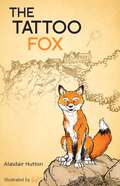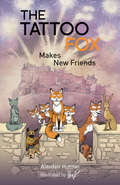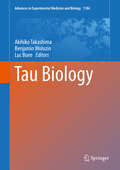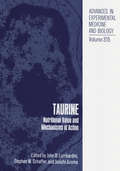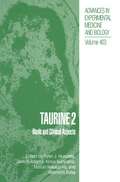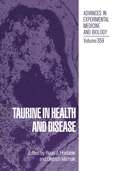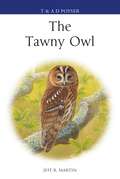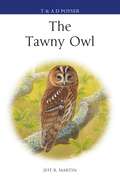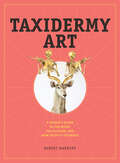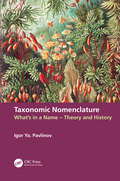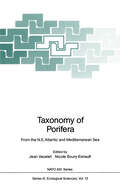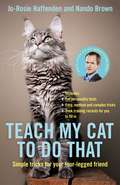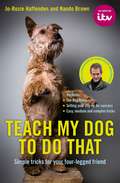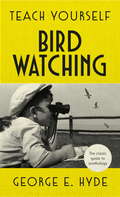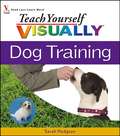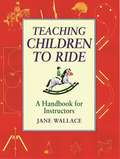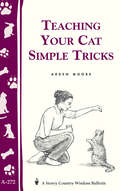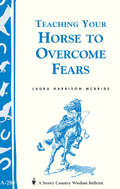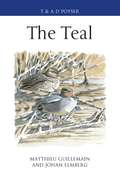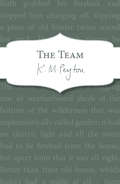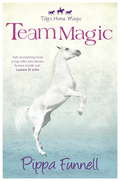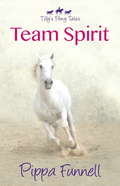- Table View
- List View
The Tattoo Fox: Makes New Friends (The Tattoo Fox #1)
by Alasdair HuttonThe Tattoo Fox is the story of a young fox who makes her home at Edinburgh Castle. Intrigued by everything she hears about the Tattoo, she endeavours to find out more. Her quest takes her to some of Edinburgh's most famous landmarks as she befriends the local animals and sees the local sights. But nothing can prepare her for the fantastic spectacle of the Royal Edinburgh Military Tattoo. BACK COVER The Tattoo was a brilliant sight The fox went back there every night. A little fox makes her home by Edinburgh Castle and with the help of her new friend, the Castle Cat, she settles in well. But there is one question the Castle Cat refuses to answer. What is the Tattoo? 'Just wait and see,' he tells her. Will she ever find out? This heart-warming tale was inspired by a real-life encounter between the Producer of the Royal Edinburgh Military Tattoo and a fox, late one night on the Castle Esplanade.
The Tattoo Fox Makes New Friends: Makes New Friends (The Tattoo Fox #2)
by Alasdair HuttonThe fox's friends all gather roundTo watch the greatest show in townAfter discovering Edinburgh's Military Tattoo and setting up her home by Edinburgh Castle, the Tattoo Fox returns to her adventures around Edinburgh. Meeting and making lots of new friends along the way (including the Queen!), the Tattoo Fox invites them all to her party.This heart-warming tale was inspired by a real-life encounter between the Producer of the Royal Edinburgh Military Tattoo and a fox, late one night on the Castle Esplanade.Hutton is one of Scotland's greatest storytellers [and] the illustrations by Stref are the icing on the cake.BRIGADIER DAVID ALLFREY MBELots of adventures [and] the famous Tattoo creates a dramatic finale to the story.JENNY BLANCH, CarouselA hit with young readers.EDINBURGH EVENING NEWS
Tau Biology (Advances in Experimental Medicine and Biology #1184)
by Akihiko Takashima Benjamin Wolozin Luc BueeThis book presents essential studies and cutting-edge research results on tau, which is attracting increasing interest as a target for the treatment of Alzheimer's disease. Tau is well known as a microtubule-associated protein that is predominantly localized in the axons of neurons. In various forms of brain disease, neuronal loss occurs, with deposition of hyperphosphorylated tau in the remaining neurons. Important questions remain regarding the way in which tau forms hyperphosphorylated and fibrillar deposits in neurons, and whether tau aggregation represents the toxic pathway leading to neuronal death. With the help of new technologies, researchers are now solving these long-standing questions. In this book, readers will find the latest expert knowledge on all aspects of tau biology, including the structure and role of the tau molecule, tau localization and function, the pathology, drivers, and markers of tauopathies, tau aggregation, and treatments targeting tau. Tau Biology will be an invaluable source of information and fresh ideas for those involved in the development of more effective therapies and for all who seek a better understanding of the biology of the aging brain.
Taurine: Nutritional Value and Mechanisms of Action (Advances in Experimental Medicine and Biology #315)
by John B. Lombardini Stephen W. Schaffer Junichi AzumaThe underlying philosophy of these two symposia on taurine remains the same as all those that have been held previously: the best way to remain current in the subject matter is to talk directly with the investigators at the forefront of the field. Thus, we brought together some 50 individuals from 11 different countries who have keen interests and active research programs in the many-faceted areas of taurine research. The meetings were held on October 8-10, 1991, in an elegant setting in a resort area at Orange Beach, Alabama, approximately 50 miles outside of Mobile on the Gulf Coast. The meetings were programmed as two separate Symposia held sequentially. The first symposia on October 8 was devoted exclusively to taurine research in the cat, primarily in the area of nutrition, and entitled "The Waltham Symposium on Taurine and Cat Nutrition". The second symposia on October 9 and 10 was open to all fields of taurine research and was entitled "International Taurine Symposium: New Dimensions on its Mechanisms of Actions". If the philosophy of these meetings was to bring both experts and novices together in a discussion and presentation of current taurine research, then the major purpose of the Proceedings is to document the current research efforts and to present an objective summary of where the taurine field stands today and where the focus will be in the future.
Taurine 2: Basic and Clinical Aspects (Advances in Experimental Medicine and Biology #403)
by Ryan J. Huxtable Junichi Azuma Kinya Kuriyama Masao Nakagawa Akemichi BabaThis volume comprises the edited proceedings of the International Taurine Sympo sium held in Osaka, Japan, in June 1995, as a Satellite Symposium of the 15th Biennial of the International Society for Neurochemistry. This Taurine Symposium was the Meeting latest in a series held since 1975 at approximately two-year intervals by an informal group of international researchers. It attracted contributions from 20 countries, ranging from Armenia via Finland and Spain to the United States. Some 121 participants attended. The Symposium was organized and chaired by Junichi Azuma, University of Osaka. Other members of the Organizing Committee in Japan consisted of Kinya Kuriyama and Masao Nakagawa, both from the Kyoto Prefectural University of Medicine, and Akemichi Baba, from Osaka University. The Committee had to contend with the disaster of the Kobe earthquake, which struck on January 21. The epicenter was only around 25 miles from the meeting site, and the quake demolished the home of one Committee member. Despite this unnaturally natural handicap, the participants experienced a superbly organized meeting, one which more than maintained the high social and scientific standards established for this series. In his Welcome Message, Dr. Azuma listed a threefold objective for the Symposium: To provide a forum for the interdisciplinary exchange of information on taurine; to give an opportunity for renewing old friendships and making new friends; and to promote coopera tion among participants from around the world.
Taurine in Health and Disease (Advances in Experimental Medicine and Biology #359)
by Ryan J. Huxtable Dietrich MichalkTaurine, or 2-aminoethane sulfonic acid, has long been known to be the major organic product formed from the breakdown of the sulfur-containing amino acids, methionine and cysteine. It is excreted as such in the urine or as bile acid conjugates in the bile. Research over the last 25 years, however, has uncovered an amazing variety of phenomena involving taurine. Despite the fact that the mechanism of action of taurine in some of these phenomena remains to be elucidated, it is clear that taurine is of far more physiological relevance than being the mere metabolic debris of sulfur amino acid catabolism. It also has numerous pharmacological actions that are beginning to be developed, as exemplified by some of the studies reported in this volume. This volume reports the proceedings of the latest of a series of international symposia, continuing on from the initial meeting held in Tucson, Arizona, in 1975. The latest symposium was the first to be held in Germany, in Cologne from August 29 through September 1, 1993. It continued the multidisciplinary approach that has been the norm for taurine symposia. We hope the publication of the proceedings will stimulate further investigations on this simple but fascinating compound.
The Tawny Owl (Poyser Monographs)
by Jeff Martin'Jeff Martin explores the Tawny Owl's natural history in the greatest detail. Where controversy has arisen in the literature, he has put forward all points of view so the reader can make his or her own judgements. There seems nothing concerning the biology of this owl that Jeff has not researched.' - Derek Bunn, author of The Barn Owl The haunting calls of the Tawny Owl can be heard from Scandinavia in the north of its range to North Africa in the south. Most people would consider it to be a common and widespread species throughout Europe, but populations in Britain at least are declining, and we need to understand more about the behaviour and ecology of this magnificent woodland bird if its future is to be secured. Jeff Martin has been studying owls for decades, and in this timely book he combines his personal observations together with those of other ornithologists and a comprehensive review of the literature, resulting in some surprising revelations. It was not long ago, for example, that the Tawny Owl was considered to be one of the most nocturnal of all owl species, but in recent years it has been observed sunbathing, calling and even hunting in broad daylight. Chapters detail the evolution and classification of this relatively young species, its status and distribution across Europe, its feeding, breeding and behavioural ecology, why numbers are falling, and what we can do about it. The book concludes by looking at the role that Tawny Owls have played in British culture, and whether the changes in behaviour and plumage among the British population could mean we have a new subspecies evolving on our island.
The Tawny Owl (Poyser Monographs)
by Jeff Martin'Jeff Martin explores the Tawny Owl's natural history in the greatest detail. Where controversy has arisen in the literature, he has put forward all points of view so the reader can make his or her own judgements. There seems nothing concerning the biology of this owl that Jeff has not researched.' - Derek Bunn, author of The Barn Owl The haunting calls of the Tawny Owl can be heard from Scandinavia in the north of its range to North Africa in the south. Most people would consider it to be a common and widespread species throughout Europe, but populations in Britain at least are declining, and we need to understand more about the behaviour and ecology of this magnificent woodland bird if its future is to be secured. Jeff Martin has been studying owls for decades, and in this timely book he combines his personal observations together with those of other ornithologists and a comprehensive review of the literature, resulting in some surprising revelations. It was not long ago, for example, that the Tawny Owl was considered to be one of the most nocturnal of all owl species, but in recent years it has been observed sunbathing, calling and even hunting in broad daylight. Chapters detail the evolution and classification of this relatively young species, its status and distribution across Europe, its feeding, breeding and behavioural ecology, why numbers are falling, and what we can do about it. The book concludes by looking at the role that Tawny Owls have played in British culture, and whether the changes in behaviour and plumage among the British population could mean we have a new subspecies evolving on our island.
Taxidermy Art: A Rogue's Guide to the Work, the Culture, and How to Do It Yourself
by Robert MarburyIn this collection of taxidermy art, you’ll find a winged monkey with a fez and a martini glass, a jewel-encrusted piglet, a bionic fawn, and a polar bear balancing on a floating refrigerator. Author Robert Marbury makes for a friendly (and often funny) guide, addressing the three big questions people have about taxidermy art: What is it all about? Can I see some examples? and How can I make my own? He takes readers through a brief history of taxidermy (and what sets artistic taxidermy apart) and presents stunning pieces from the most influential artists in the field. Rounding out the book are illustrated how-to lessons to get readers started on their own work, with sources for taxidermy materials and resources for the budding taxidermist.
Taxonomic Nomenclature: What’s in a Name – Theory and History
by Igor Ya. PavlinovThis book suggests an in-depth look at nomenclature in systematics instead of providing another "instruction for use" of various Codes of nomenclature. The focus is on ideas of what taxonomic nomenclature is as a part of the professional language of systematics considered in its full historical and conceptual scope. Basic concepts of nomenclature are outlined, and their development characterized; a hierarchy of fundamental principles of nomenclature are summarized; and the relationship between taxonomic nomenclature and taxonomic theory discussed. This book is addressed to those who would like to go beyond the boundaries of existing Codes to look at the subject from a more general, mostly theoretical standpoint. Key Features • Provides a review of the role of nomenclature in systematics • Reviews the conceptual scope and historical contexts of nomenclature • Analyzes fundamental principles of nomenclature • Outlines the historical development of nomenclature • Reviews the rules of nomenclature in botany, zoology, microbiology, and horticulture Related Titles Mishler, B. D. What, If Anything, Are Species? (ISBN 978-1-4987-1454-9) Pavlinov. I. Ya. Biological Systematics: History and Theory (ISBN 978-0-367-65445-0) Rieppel, O. Phylogenetic Systematics: Haeckel to Hennig (ISBN 978-0-367-87645-6) Wilkins, J. S. Species: The Evolution of an Idea, 2nd ed. (ISBN 978-0-367-65736-9)
Taxonomic Nomenclature: What’s in a Name – Theory and History
by Igor Ya. PavlinovThis book suggests an in-depth look at nomenclature in systematics instead of providing another "instruction for use" of various Codes of nomenclature. The focus is on ideas of what taxonomic nomenclature is as a part of the professional language of systematics considered in its full historical and conceptual scope. Basic concepts of nomenclature are outlined, and their development characterized; a hierarchy of fundamental principles of nomenclature are summarized; and the relationship between taxonomic nomenclature and taxonomic theory discussed. This book is addressed to those who would like to go beyond the boundaries of existing Codes to look at the subject from a more general, mostly theoretical standpoint. Key Features • Provides a review of the role of nomenclature in systematics • Reviews the conceptual scope and historical contexts of nomenclature • Analyzes fundamental principles of nomenclature • Outlines the historical development of nomenclature • Reviews the rules of nomenclature in botany, zoology, microbiology, and horticulture Related Titles Mishler, B. D. What, If Anything, Are Species? (ISBN 978-1-4987-1454-9) Pavlinov. I. Ya. Biological Systematics: History and Theory (ISBN 978-0-367-65445-0) Rieppel, O. Phylogenetic Systematics: Haeckel to Hennig (ISBN 978-0-367-87645-6) Wilkins, J. S. Species: The Evolution of an Idea, 2nd ed. (ISBN 978-0-367-65736-9)
Taxonomy of Porifera: From the N.E. Atlantic and Mediterranean Sea (Nato ASI Subseries G: #13)
by Jean Vacelet Nicole Boury-EsnaultAlthough sponges are one of the major components of littoral ecosystems, their systematics obviously lags behind that of the majority of other groups of marine invertebrates. Also the evolutionary trends in these most primitive of the Metazoans are poorly understood. The confused state of their taxonomy and the difficulties with their identification prevent their use in ecological studies. The emphasis of interest presently seems to have shifted towards chemistry, but many of the hundreds of interesting chemicals recently described in sponges pro bably have been found in mistakenly or imprecisely identified animals. This situ ation will become worse in the next few years, when a number of experts will retire and will not be replaced by new ones, owing to the difficulties that the science of systematics is facing in most countries - as exemplified during this meeting by an informal discussion on the endangered future of European Museums. Under these circumstances, it is the responsability of present sponge taxono mists to leave a less confused state and tools such as simple fauna or computerized data bases to generations following. These tools do not exist even in one of the best studied areas, the North-Eastern Atlantic (including the Mediterranean Sea).
Teach My Cat to Do That
by Jo-Rosie Haffenden Pilmsoll Productions Nando BrownJoin Jo-Rosie Haffenden and Nando Brown, the animal trainers from ITV’s hit show Teach My Pet To Do That, as they reveal the surprising truth about training cats. You might think that cats don’t do obedience, but this simple, practical guide will have you and your cat mastering the basics of trick training in no time and will open up a whole new world of fun for both of you. Whether your feline is shy and retiring, or loves the limelight, there’s something in Teach My Cat to Do That for every personality type. Trick-training is a great way to get to know your cat better, deepen your bond and help keep them keep fit and stimulated. Full of hints, tips and photographs, and taking you from the very simplest training fundamentals to show-stopping tricks like ‘Ring the Bell for Dinner’ and ’Wipe Your Feet’, the only limit to where you end up is your imagination.
Teach My Dog To Do That
by Jo-Rosie Haffenden Nando Brown Pilmsoll ProductionsJoin Jo-Rosie Haffenden and Nando Brown, the animal trainers from ITV’s Teach My Pet To Do That, as they reveal how any dog can learn new tricks.This simple, practical guide will have you and your pooch mastering the basics of trick training in no time and opening up a whole new world of fun for both of you. Whether they’re shy and retiring, or love the limelight, in Teach My Dog to Do That, there’s something for every type. Trick-training is a great way to get to know your dog better, deepen your bond and help keep them keep fit and stimulated. Full of hints, tips and photographs and taking you from the very simplest training fundamentals to show-stopping tricks like “Dog Yoga” and “Tidy Your Toys”, the only limit to where you end up is your imagination.
Teach Yourself Bird Watching: The classic guide to ornithology
by GE HydeWith a few sorry exceptions, it's heartening to think that the gardener or bird-spotter of the 1950s or 60s would immediately recognise most of the songs that sing out over English gardens today. For the amateur ornithologist of the twenty first century, Teach Yourself Bird Watching will be as much of a delight now as it ever was - a beautifully written, precise guide to identifying, protecting and encouraging birdlife in your garden and beyond.Since 1938, millions of people have learned to do the things they love with Teach Yourself. Welcome to the how-to guides that changed the modern world.
Teach Yourself VISUALLY Dog Training
by Sarah HodgsonWhen you're training your dog, he won't sit still for long-winded explanations. You don't have to, either! With this visual guide, you'll quickly learn how to determine your dog's personality, customize a training plan, and speak Doglish. You'll get the scoop on training tools, everyday handling, puppy conditioning, and socialization. You'll learn how to teach basic commands and progress to fun tricks and games. Instead of poring over boring text, you'll get the picture and enjoy working with your soon-to-be well-trained dog! Concise two-page lessons show you all the steps to a skill and are ideal for quick review * Each tool, principle, or training technique is clearly described * Detailed color photos demonstrate each step * Step-by-step instructions accompany each photo * Helpful tips provide additional guidance
Teaching Children to Ride: A Handbook For Instructors
by Jane WallaceLearning to ride should be fun, progressive and constructive but all too often children can be easily frightened or put off. Teaching them is not easy. This book offers advice, exercises, lesson plans, games and teaching tips designed to provide variety and sound instruction, plus a fund of innovative ideas for making learning to ride an enjoyable, worthwhile and satisfying experience, even for the very young. Includes advice on planning a lesson; teaching the basi; starting and finishing lessons; mid lesson breaks; fun exercises for early lessons; trotting and using poles; cantering and introducing jumping; advanced work for older children; riding out and mounted games. 'A truly wonderful book, full of inspirational, challenging ideas... a must for anyone wanting their children to grow into riders that are good enough to enjoy and succeed in any area of riding'. Lucinda Green
Teaching, Research, Innovation and Public Engagement (New Paradigms in Healthcare)
by Ourania VarsouThis volume is a unique compendium of professional and practical knowledge on new paradigms and approaches in Teaching, Research, Innovation and Public Engagement that is currently missing from the Higher Education market. The intended audience includes healthcare, biomedical and physical sciences discipline specialists active in teaching, along with their students, science communicators associated with the above subjects and academics involved in relevant research/innovation. Its contents will be organised under the following three themes: 1) Scholarship of Teaching and Learning discussing pertinent knowledge, in this area, and inspiring educators to pursue similar medical humanities endeavours. The focus is on pedagogy/teaching including professional knowledge/expertise, reflections, literature reviews and evidence on a wide range of medical, biomedical and physical sciences topics interweaved with humanities. 2) Research and Innovation discussing novel work and paradigms as examples for future use/implementation. The focus is firstly on original research utilising cutting-edge technology and secondly on innovation with discussions around poetry and building communities. 3) Public Engagement discussing relevant science communication paradigms transferable to other settings and applications. The focus is on practical knowledge and examples from a wide range of healthcare and biomedical sciences topics interweaved with humanities while also exploring the hidden curriculum of public engagement and heritage practices through the lens of equality, diversity and inclusion. All chapter authors are renowned experts in their respective fields, who bring together a wealth of professional and practical knowledge, enriching the narrative of this edited book volume.
Teaching Your Cat Simple Tricks: Storey's Country Wisdom Bulletin A-272 (Storey Country Wisdom Bulletin)
by Arden MooreCats love to be in the spotlight. While not every cat will take to learning tricks, most will thrive on the extra attention and love you'll shower on them during training sessions. And whether you want to teach your cat to sit up, fetch, walk on a leash, or simply come when called, Arden Moore's simple and encouraging instructions will show you how. You'll have your cat performing like a stage star in no time!
Teaching Your Horse to Overcome Fears: (Storey's Country Wisdom Bulletin A-280) (Storey Country Wisdom Bulletin)
by Laura Harrison McBride"De-Spook" Your HorseAn umbrella opening, a tree branch creaking, a tarp flapping in the wind, a dusty shadow in the back of the barn -- what seems benign to the human eye often terrifies a horse. His immediate response? Screech to a halt, buck, twirl, and run like the dickens! What can a rider do but hang on?In fact, there is plenty a rider can do to "de-spook" a horse, and Teaching Your Horse to Overcome Fears tells you how. Following the advice of renowned trainers such as John Lotito, Pat Parelli, and Mark Rashid, you'll learn how to reprogram your horse's fear response so that, when startled, he may unnerve you, but he won't unseat you. These trainers offer proven tips on training your horse in a manner that is gentle, effective, and long-lasting. And you'll delve into the most exciting "alternative" therapies for high-strung horses, including herbal remedies, aromatherapy, shamaniac healing, and body work.
The Teal
by Matthieu Guillemain Johan ElmbergSmall, noisy and colourful, the Teal is a familiar duck throughout the wetlands and waterways Europe and Asia. Once hunted extensively for the pot, its numbers have recovered and it is now one of our commonest species of waterfowl. A flagship species for wetland conservation, the Teal is also an excellent model species for ecological research, and this forms the spine of this new Poyser monograph. The Teal looks at distribution and trends in numbers, foraging ecology, breeding behaviour), population dynamics, management and conservation of teal, looking at both the Eurasian Common Teal and its North American equivalent, the Green-winged Teal (which until relatively recently was considered to be the same species). The book provides a scientifically robust account on which wetland managers, research scientists and the ornithological community may rely, with wider implicatons for the conservation and management of other waterfowl, and for ecological research in general.
The Teal
by Matthieu Guillemain Johan ElmbergSmall, noisy and colourful, the Teal is a familiar duck throughout the wetlands and waterways Europe and Asia. Once hunted extensively for the pot, its numbers have recovered and it is now one of our commonest species of waterfowl. A flagship species for wetland conservation, the Teal is also an excellent model species for ecological research, and this forms the spine of this new Poyser monograph. The Teal looks at distribution and trends in numbers, foraging ecology, breeding behaviour), population dynamics, management and conservation of teal, looking at both the Eurasian Common Teal and its North American equivalent, the Green-winged Teal (which until relatively recently was considered to be the same species). The book provides a scientifically robust account on which wetland managers, research scientists and the ornithological community may rely, with wider implicatons for the conservation and management of other waterfowl, and for ecological research in general.
The Team
by K M PeytonRuth has outgrown her beloved pony, Fly. She needs to find a good home for Fly, and a new pony for herself. She knows the sad, shabby chestnut she sees at the local auction isn't right for her - but she's determined to make him hers.
Team Magic: Book 4 (Tilly's Horse, Magic #4)
by Pippa FunnellTilly Redbrow doesn't just love horses - she lives, breathes and dreams them too!Tilly's over the moon when she's picked for the Novice Championships. She and Magic are perfect together. But the pressures take their toll and her dreams die when Fred Webb takes Magic away from her. Will Tilly ever be reunited with the horse she can't bear to live without?Packed with expert advice from champion rider and Grand Slam winner, Pippa Funnell, on everything you ever wanted to know about horses, and perfect for all fans of NATIONAL VELVET and Lauren St John's One Dollar Horse trilogy.
Team Spirit: Book 1 (Tilly's Horse, Magic #1)
by Pippa FunnellTilly Redbrow doesn't just love horses - she lives, breathes and dreams them too!Tilly is fourteen now and has had her beautiful grey, Magic Spirit, for over three years and they're inseparable. She's thrilled they've been chosen for the Pony Club Eventing Championship team. Together with Ben, Kya and Anna - they face the challenges of dressage, cross country and show jumping against tough competition. And they learn that good teamwork is not always as easy as it looks.Packed with expert advice from champion rider and Grand Slam winner, Pippa Funnell, on everything you ever wanted to know about horses.
